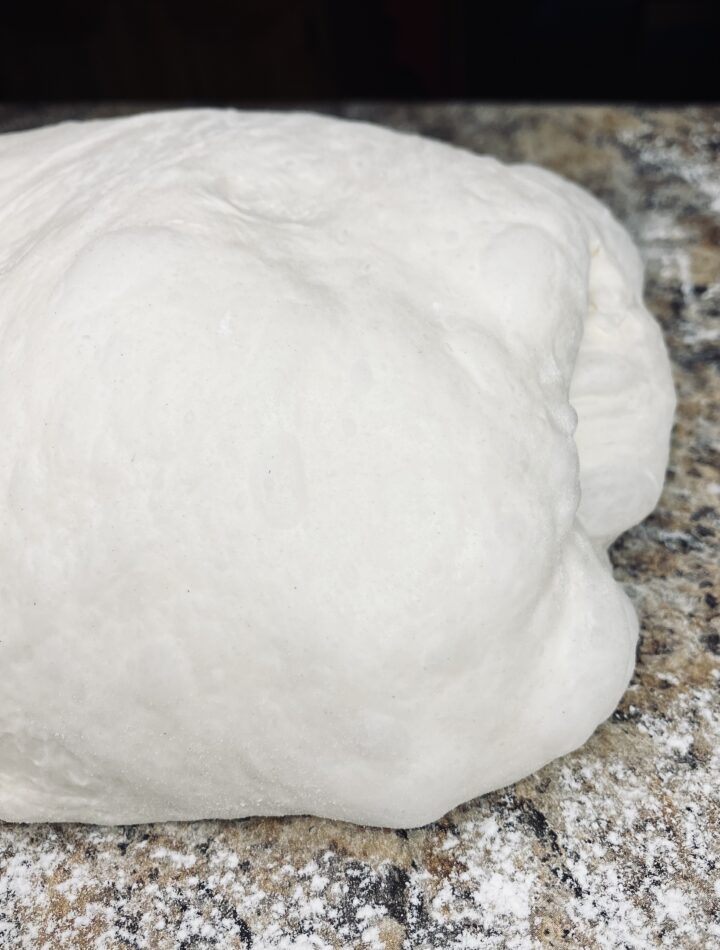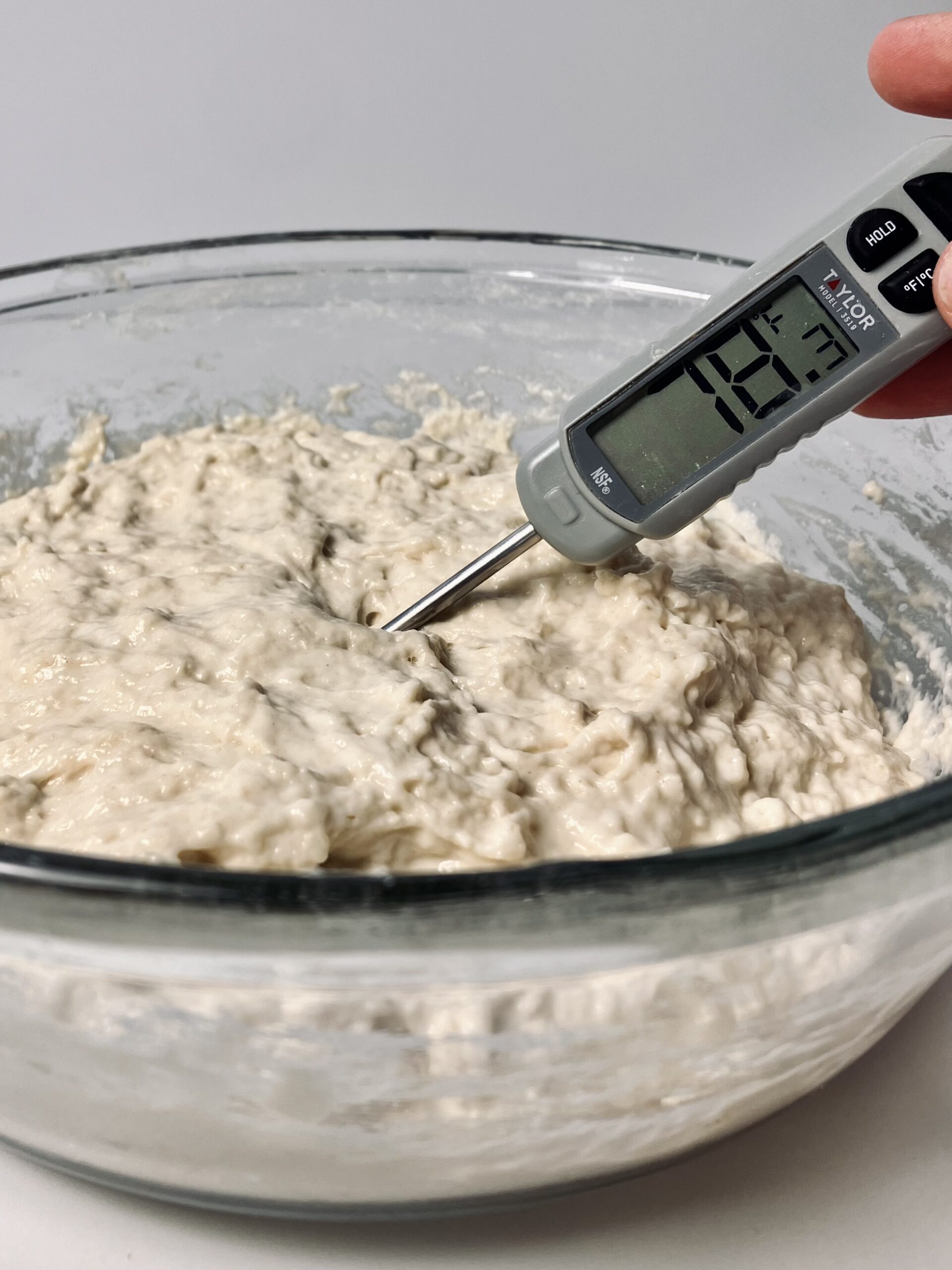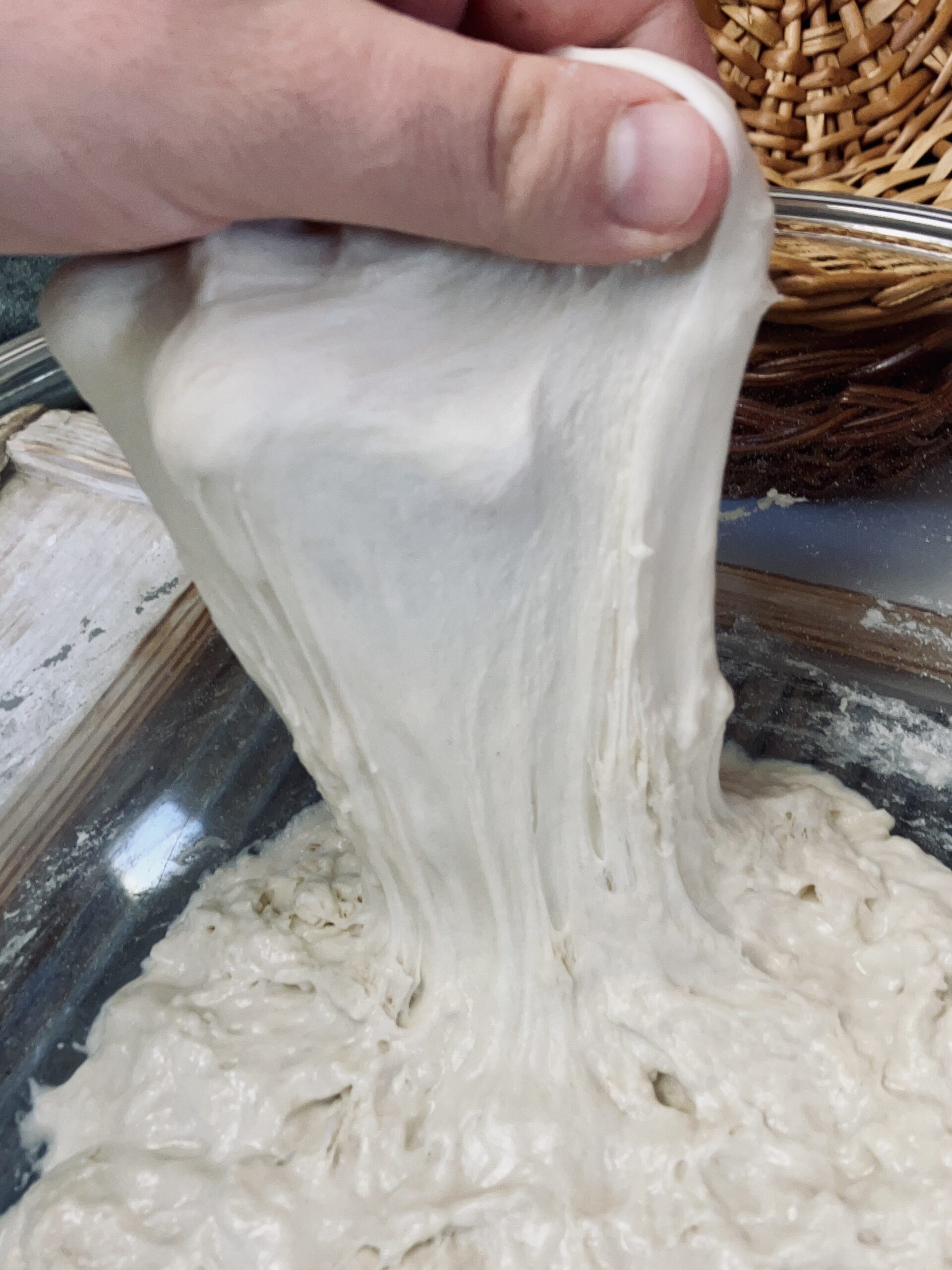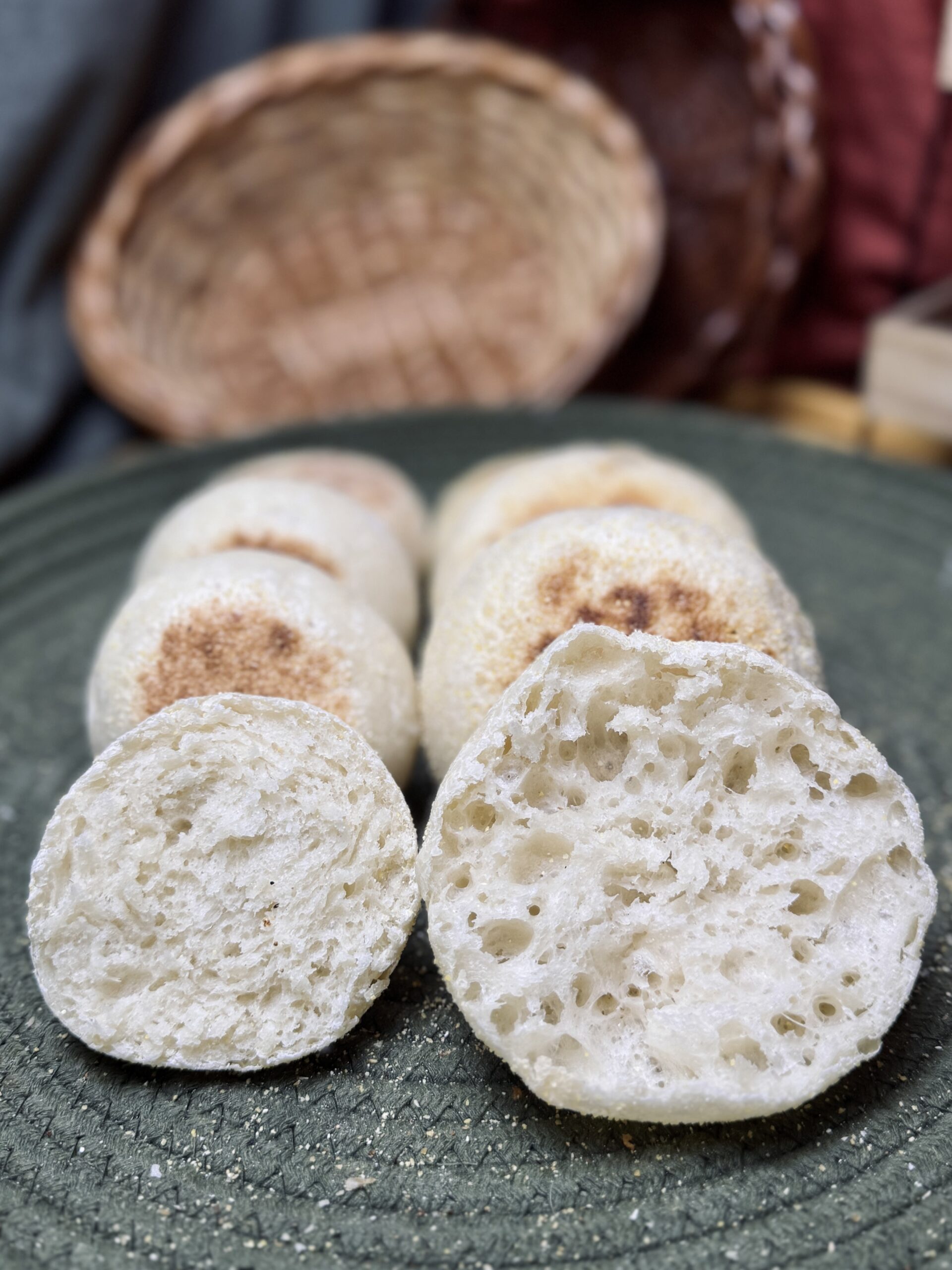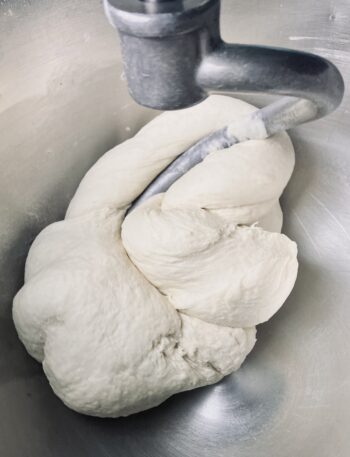Bread would not be possible without gluten. Bread that traps air and holds itself together, that is. Developing gluten can be a task, albeit a necessary one. Every ingredient added to the dough changes the network, affecting the way the dough behaves. As bakers, we must know how to navigate these ingredients, the development of this network, and how the state of our gluten ties to fermentation in order to produce the best bread. Let’s take a deeper dive into gluten below.
What Is Gluten And Why Do I Need It?
Pull up on a piece of your bread dough. Does it tear immediately, or does it stretch a bit? For the dough to stretch without tearing – this is a sign that gluten is present.

Baker’s check the state of their gluten by evaluating the dough’s “windowpane.” Can the dough stretch to a point where it can be seen through? How clear is the window? Is it completely see-through, or are there still some dark patches? How easy or difficult is it to stretch the dough to this point? How far can the dough be stretched before it begins to tear?
Gluten is a group of proteins, the most notable being gliadin and glutenin, found in wheat and other grains like barley and rye. They bond naturally over time, or unnaturally when bakers knead their bread dough. When these proteins come together, they form a network that traps air from fermentation.
You can think of gluten like the rubber on a balloon. When you mix flour and water to make dough, the gluten proteins stick together and create a network. This is similar to stretching a balloon before blowing it up. The stretching makes the balloon flexible and ready to hold air. As you knead the dough, the gluten network becomes stronger and stretchier, just like a balloon that can hold more air without popping.
In bread dough, microorganisms (yeast and bacteria) create gas bubbles. The gluten traps these bubbles, causing the dough to rise and increase in volume. When you blow air into a balloon, it expands because the rubber holds the air inside. In the oven, the gluten continues to hold in the gas bubbles, making the bread fluffy and helping it keep its shape. Just like how a balloon keeps its shape when you tie it off, gluten helps the bread maintain its form as it bakes.
Conclusion
In summary, gluten is a group of proteins that come together to create a network that helps the dough stretch, trap gas bubbles, and rise to create delicious, fluffy bread. Without gluten, your bread would be flat, cracked, and have a dense texture.
Extensibility Versus Elasticity
There are two important parts to how gluten is developed in bread dough: extensibility and elasticity.

Extensibility
When you hear the word “extensibility,” picture in your mind your fingers picking up a small piece of dough and lifting it up, up, up. As you lift the dough, it doesn’t tear. It just keeps stretching without breaking. This dough is extensible.
You can also check for extensibility by inspecting the dough for a “windowpane” effect. When you pull a piece of dough apart, if it stretches and becomes thin enough to see through, that means the dough has good extensibility. The more see-through the windowpane is, the better the dough can stretch.
Extensibility is necessary and good, but it is also represents weakness. Too much extensibility can lead to a loaf that is flat, without good form.
There are many ways to create extensibility in your bread dough, some of them good, some of them not so good, and everything being best in balance and moderation. Let’s talk about each:
Autolyse
Autolyse is when flour and water are mixed together and allowed to rest for a period of time before adding other ingredients, such as sourdough starter and salt. During autolyse, gluten naturally comes together and the dough becomes more extensible. This is because an enzyme called “protease” breaks down the proteins in the flour into smaller pieces called peptides and amino acids. This breaking down of the flour is what creates extensibility. Eventually, though, proteases will break down the flour completely and over-autolyse will occur.
Kneading
You can knead the dough for longer periods of time or at higher speeds to create extensibility. Whacking the dough around in the mixer breaks gluten bonds and creates an extensible dough. However, it is possible to over-knead. When this happens, too much of the gluten is broken and the dough becomes overly-extensible, sticky, and hard to manage.
Hydration
The reason some baker’s love high hydration doughs or attribute them to open crumb is because the extra water creates extensibility. A wetter dough is able to stretch more. However, doughs with too much water can be more difficult to work with and, in some cases, may take more time and effort to appropriately form gluten.
Over-Proofing
Fermenting your dough for too long will create a highly extensible dough that falls flat again. This is one of the methods that you do not want to strive for. However, an “over-proofed” bread is usually a very airy and soft. In my opinion, it is better to over-proof your bread dough than to under-proof it.
Over-proofing is a combination of the balance of microorganisms coming from your sourdough starter that are transferred over to your bread dough paired with the balance of extensibility/elasticity in the dough paired with how long the dough has been fermented for and at what temperature it has been fermented. As you can see, it is a very complex subject.
One common way for bread dough to over-proof is for yeast to “pop” the bubble or balloon that is the gluten network because the dough could not hold in all the air that was produced. Alternatively, another very common, and generally unheard of, way for bread dough to over-proof is when lactic acid bacteria (LAB) eat away at the proteins in flour, eventually breaking it down completely, making it extensible. This can be a very common problem, especially among home sourdough bakers, because there are many who do not know or understand how to tell when there are too much LAB being transferred over from the starter to the bread dough or how to maintain the starter to reduce the number of LAB (which reproduce faster than yeast). Just like natural enzymes break down proteins in flour, which create a more extensible dough during autolyse, LAB also break down proteins in flour that create extensibility, and can eventually cause bread dough to “over-proof,” sometimes before yeast can fully aerate the dough.
Add A Bit Of Spelt To The Mix
Spelt is known for its highly extensible gluten network. Adding a little bit of spelt to your flour blend can help encourage extensibility.

Elasticity
Elasticity is the opposite of extensibility. Let’s go back to that picture in your mind of your fingers picking up a small piece of dough and lifting it up, up, up. An extensible dough will lift higher and higher easily, without tearing. Now imagine the dough begins to fight you. It pulls back in the other direction. It does not want you to stretch it out, it wants to bounce back to the comfy dough ball it was before you tried to stretch it. This is elasticity. It’s the strength of your dough.
You can see how elastic your dough is by inspecting the “windowpane.” How hard is it to stretch the dough to a see-through consistency? How thick is the dough after it has been stretched as far as it will go? A thicker windowpane that is more resistant to stretching is more elastic than a very thin windowpane that stretches easily.
Elasticity is necessary and good, representing strength. However, like everything, it is only good in moderation. While elasticity makes the dough stronger, it is possible for it to become too strong. It takes more air to blow up a balloon with thick rubber. You need enough strength that the dough will stand firm without collapsing, but not so much that the microorganisms in your dough cannot blow it up. More elasticity in bread dough means a longer fermentation.
Certain ingredients and techniques contribute to a more elastic gluten network. Let’s talk about them below:
Kneading
When you knead bread dough, you create elasticity. Moving and stretching the dough makes it stronger. For more strength, handle the dough with care. Knead it at low speeds and not for too long. As I mentioned above, kneading the dough at high speeds or for longer periods of time creates the opposite – an extensible dough. In order to knead and obtain an elastic dough, you’ll want to be more gentle with your dough.
A Note On Folds
Folds do not create elasticity in your gluten structure. Folds help develop the dough overall, but not by creating a stronger gluten network. Folds create another component called, “tension.” Tension gives the dough strength for a moment, but once the dough is given a chance to relax, that strength goes away.
Elasticity does not go away. The only way it can be destroyed is by an over-proofed bread dough.
Lamination
Lamination is when the dough is turned out onto a clean working surface and stretched to its max. The dough is then carefully folded and returned to a proofing container to finish fermenting.
By stretching the dough (not tearing it!), the gluten is being worked to its full potential. This intense stretching increases elasticity in bread dough.
Tightening Agents
Certain ingredients added to bread dough create a tighter, stronger, more elastic network. You’ll often find that when these ingredients are added to bread dough, the dough behaves differently and the resulting crumb is finer and denser. That’s because tightening agents tend to give the dough a thicker skin that is more like the rubber on a car tire than a balloon. Depending on the ingredient and how much it tightens the dough, the dough becomes very hard for your microorganisms to blow up. Examples of tightening agents include: salt, milk, cocoa powder, eggs, beetroot powder, etc. The amount that the dough is tightened by each ingredient varies depending on the ingredient and how much is added to the dough.
When certain tightening agents are included in a recipe, the process must change. For one, some tightening agents make it harder for gluten to form in the first place. Then, once gluten does form, it is… well… tight. Because the dough is more elastic, it will not respond to folding in the same way. A dough that is too elastic will struggle to relax after receiving tension through folds. When working with these ingredients, the baker will need to find ways to make the dough more extensible in order to keep it workable and to help the dough ferment properly.
Hydration
Just like higher hydration doughs are more extensible, lower hydration doughs are more elastic. However, just as too much water can make it harder for gluten to form, so can too little water. Everything is good in moderation!
Flour Choice
Some flours, such as whole wheat, naturally absorb more water, creating a more elastic dough.
Conclusion
It’s important not to view one or the other (extensibility or elasticity) as “good” or “bad.” Everything is good in moderation, and the strength of our gluten network is no different. We must find the perfect balance of each for the bread we are making. The dough must be weak enough that it can be easily blown up by our microorganisms and expand in the oven, yet not so weak that it over-proofs too quickly. Conversely, the dough must be strong enough that is can hold its shape and stand firm, yet not so strong that it cannot ferment at all.
What Is Protein Content And Why Is It Important?
When bakers use the word “protein content,” they are talking about how much protein is in their flour. Since gluten is formed via the bonding of various proteins (most notably gliadin and glutenin), the higher the protein content of the flour, the more potential it has for gluten development.
Now, when we step out of the realm of white flour, protein content can get complicated. The bran and germ of whole grains contain protein, but their proteins are different and do not contribute to the development of gluten.
Some brands are very open about the protein content of their flour, even displaying it on the packaging (such as King Arthur). Other brands may not display the protein content, instead they distinguish between the flour they recommend for certain types of bread (such as Bob’s Red Mill).

Generally speaking, white flour can be divided into three categories:
- Bread flour: Bread flour contains the highest amount of protein (12-14%), meaning it has the potential to develop the strongest gluten network.
- All-purpose flour: All-purpose flour contains a moderate amount of protein (10-12%), making it versatile, suitable for a wide range of baked goods with balanced gluten development.
- Cake flour: Cake flour contains the lowest amount of protein (7-9%), meaning gluten development is minimal. This results in a tender and crumbly texture, perfect for cakes and pastries.
Both bread flour and all-purpose flour can be used for bread. The difference is how easily gluten will develop and how strong it can become. An all-purpose flour or low-quality bread flour will require more effort to develop the same strength of gluten as a high-quality bread flour will develop naturally. If you do not have access to a good flour for bread, try adding vital wheat gluten to your dough. Though it looks like flour, it is straight gluten and will help encourage a strong gluten network in your dough.
How Is Gluten Different In Different Types of Flour?
Every type of flour has a different relationship with gluten. The proteins in each are different, affecting the ease of gluten formation, as well as the extensibility/elasticity of the gluten network. This is why it is so important to work with a single flour type until mastery, rather than playing around with various flours. Because every type of flour has a different relation to gluten, the way the dough behaves and the way it needs to be handled is different. Let’s talk about a few common alternatives to modern white flour, their protein content, and their relationship to gluten below:
Whole Wheat Flour
Whole wheat flour has a similar protein content to white wheat flour but includes the bran and germ, which can interfere with the formation of a strong gluten network. Bran can cut through gluten strands, resulting in a denser and coarser texture. Whole wheat flour also absorbs more water which can affect gluten formation as well.
Rye Flour
Rye flour contains proteins that can form gluten, but these proteins are less efficient at creating the strong, elastic network seen in wheat flour. This is because rye has high levels of pentosans (complex carbohydrates) that interfere with gluten formation. The gluten network in rye dough is weak, resulting in denser and moister baked goods. Because of this, rye dough is stickier and less cohesive, absorbing a lot of water.
Spelt Flour
Spelt flour has a relatively high protein content, similar to or slightly higher than that of wheat flour, but its gluten structure is different. The gluten in spelt is more soluble and extensible than the gluten found in modern wheat, which means the dough is stretchy but less stable. In other words, since it lacks elasticity, the balloon can “pop” easier. Bread made with spelt flour holds in air and can expand well during fermentation; however, it may not hold its shape as well as wheat dough.
Kamut Flour
Kamut, also known as Khorasan wheat, has a high protein content, similar to, or even higher than, modern wheat. The proteins in Kamut can form gluten, but, similar to spelt flour, the nature of the gluten is different. The gluten formed from Kamut tends to be more fragile and extensible than modern wheat. While Kamut can produce a strong gluten network, it can be more difficult to achieve the same elasticity found in bread flour made from modern wheat, potentially leading to a more tender bread.
Einkorn Flour
Einkorn is one of the oldest forms of cultivated wheat and has a protein content similar to or slightly lower than modern wheat. However, the gluten proteins in einkorn are quite different. The gluten in einkorn is weaker and less elastic than that found in modern wheat. Einkorn dough tends to be stickier and less cohesive, making it more challenging to work with. The resulting gluten network is delicate, leading to a more crumbly and tender texture in baked goods.
How Does Dough Hydration Affect Gluten Development?
Hydration simply means water. How much water did you add to the dough? Hydration is typically expressed as a percentage, which tells bakers how wet or dry their dough is. Water is essential for hydrating the gluten proteins, allowing them to unfold and bond together. Without sufficient water, gluten struggles to form. Conversely, too much water can also make it difficult for gluten to form.
Hydration is relative. Different flours can absorb different amounts of water. It is important to hydrate your dough according to the needs of the flour you are using.
Even still, you can hydrate your flour differently depending on the recipe and the outcome you are trying to achieve.
Low hydration doughs are stiff doughs. They are hydrated, albeit minimally. The absence of sufficient water in these doughs gives limited mobility to the gluten proteins, hindering the formation of a strong gluten network. Though the lack of water limits gluten’s ability to develop a strong network, the additional flour works to help the dough hold its shape. The resulting bread is usually denser and more tender than breads made with adequate water.
Moderate hydration doughs are somewhere in the middle of stiff and loose. They have enough water for gluten proteins to interact and form a cohesive and elastic network, allowing gluten to form naturally on its own.
High hydration doughs have a lot of water, making them very loose and harder to work with. The excess water allows gluten proteins to move more freely, almost too freely, making it more difficult for gluten to bond. Though the excess water can make it difficult for the dough to come together, it also makes the dough more extensible, which can help support an open crumb.
What Other Ingredients Affect The Formation Of Gluten?
In the same way that every flour has a different relationship to gluten, and the amount of water affects gluten’s ability to come together, every ingredient added to bread dough can affect gluten as well. Examples include: tightening agents, fats, and enzymes.
Tightening agents help to make the gluten network stronger. In other words, they create elasticity. Elasticity helps the dough trap gases that form during the fermentation process. However, it is important to add just the right amount of whatever tightening agent you are working with. Too much of any tightening agent can create an overly-elastic dough that struggles to expand, slowing fermentation. Examples of tightening agents include: salt, milk, cocoa powder, eggs, beetroot powder, etc.
Fats, such as butter, oil, or shortening, can coat gluten proteins, preventing them from hydrating properly and bonding to form a strong network. It is important to develop doughs with high percentages of fat to a full windowpane during mixing, as gluten will not come together properly on its own.
Enzymes, such as proteases from malted barley flour, break down gluten proteins into smaller fragments, which can make for a more extensible gluten network. Controlled enzyme activity can be especially helpful when using freshly milled whole grain flours, which, on their own, produce a tighter dough.
The Connection Between Gluten And Fermentation
At this point, you (hopefully) understand that gluten is a network formed by proteins that come from wheat. This network helps trap air from fermentation, allowing the dough to expand and hold its shape. The gluten network can be described as extensible (stretchy, weak) or elastic (firm, strong). The balance of extensibility/elasticity in your dough’s gluten network can change, depending on a variety of factors, including: flour type, hydration, ingredients, and technique.
The balance of extensibility/elasticity in your dough also affects fermentation. Let’s go back to the balloon analogy:
- A very thin rubber is flimsy and cannot hold much air. The balloon will pop sooner.
- A very thick rubber is incredibly strong. It is hard to get the balloon to expand at all. It requires more air to blow up.
Therefore, the thicker the rubber on the balloon, the more air it requires to blow it up.
This is the same concept as gluten and bread dough. The more extensible the gluten network, the less air it requires to blow up. The network is less stable; it will “pop” easier. Conversely, the more elastic the gluten network, the more air it requires to blow up. The dough is strong and struggles to expand. Therefore, the more elastic the gluten network, the longer the fermentation. The more extensible the gluten network, the shorter the fermentation. We must have the right balance of each (extensibility and elasticity) in our bread dough in order to make the best bread.
Finding The Right Balance
The right balance is dependent on the baker’s personal preference in combination with the results they are trying to achieve. There is no “right” or “wrong,” there just “is.” However, bread dough with a good balance of extensibility/elasticity is usually domed on the edges and has medium-size bubbles visible on the surface of the dough.

Signs Your Dough Might Be Too Extensible
- The dough ferments too quickly
- You notice bubbles popping on the surface of the dough before you suspect fermentation should be complete
- The dough will not hold its shape because it is so loose
- The banneton is wet after the dough is turned out of it
- The bread is flat after being bake, despite being properly fermented
- The crumb is too open, displaying abnormally large holes, despite being properly fermented and all other variables being correct
Try mixing the dough for longer (five minutes is a good number), laminating the dough in place of the first or second set of folds, or adding an extra set of folds to increase tension during fermentation. If it is your flour that is the problem, try adding vital wheat gluten.
Signs Your Dough Might Be Too Elastic
- The dough is struggling to ferment; it is barely rising
- The dough is barely showing any bubbles on the surface, and if it is, they are small
- The dough is hard to shape because it is so firm
- The dough is not sticky at all
- The bread does not spring up in the oven; instead, the oven spring is minimal and you can see cracks inside the opening where the loaf was scored
- The crumb is closed, despite a long fermentation and all other variables being correct
Try reducing the number of folds to create a more relaxed dough, eliminate lamination, or reduce the time you spend mixing/kneading the dough in order to increase extensibility.
Conclusion
Gluten is a fascinating and necessary phenomenon in sourdough bread-making. Without gluten, our dough cannot hold in air or keep its shape. The extensibility/elasticity of gluten must be balanced in order to achieve the characteristics you are looking for in your bread. Every little thing makes a difference.

